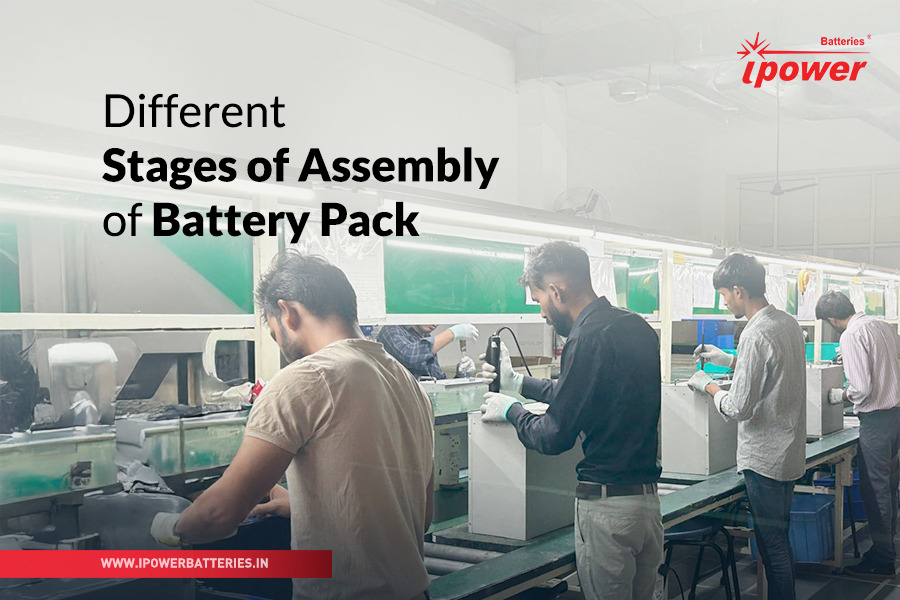Battery packs are the backbone of modern energy storage solutions, powering everything from electric vehicles to renewable energy systems. At iPower Batteries, a leading lithium battery pack manufacturer in India, we take pride in our comprehensive, precision-driven battery pack assembly process that ensures reliable and long-lasting battery packs. In this article, we outline the different stages of assembly that we use to produce high-quality lithium battery packs, focusing on safety, efficiency, and the advanced techniques we employ at each step.
Cell Selection and Grading in Battery Pack Assembly
The foundation of a reliable battery pack begins with selecting the right cells. At iPower Batteries, we source high-quality lithium-ion cells from reputable manufacturers and then perform an extensive grading process. This step ensures that all cells meet our strict quality standards for performance, capacity, and lifespan.
- Quality Checks: Each cell undergoes voltage, capacity, and internal resistance testing.
- Sorting and Pairing: Cells are grouped based on their performance characteristics to ensure uniform energy output across the pack.
This meticulous cell grading process is crucial for creating battery pack assemblies with optimal balance, extended lifespan, and improved thermal management.
Cell Arrangements and Mechanical Design
Once the cells are selected and graded, they are arranged into specific configurations based on the application requirements. Our engineering team at iPower Batteries designs custom configurations to meet the voltage and capacity demands of our customers.
- Series and Parallel Arrangements: Cells are connected in series to increase voltage or in parallel to boost capacity, as per the specifications.
- Structural Support: We employ high-strength brackets and holders to secure cells in place and protect them from mechanical stress.
Our mechanical design ensures that cells remain stable and secure throughout the battery pack assembly lifecycle, even in challenging operating conditions.
Spot Welding and Electrical Connections in Battery Pack Assembly
The cells are connected through a process known as spot welding, which uses controlled electric pulses to fuse cells to the battery terminals.
- High Precision Spot Welding: At iPower Batteries, we use advanced spot-welding machines to create durable connections that withstand vibrations and temperature variations.
- Inter-cell Connectors: High-quality nickel strips or copper connectors are used for efficient current flow between cells.
Proper welding techniques and materials are essential in battery pack assembly to minimize electrical resistance, which in turn reduces heat generation and increases battery efficiency.
Incorporating Battery Management System (BMS)
The Battery Management System (BMS) is an integral component in any lithium battery pack. The BMS monitors and controls the battery’s charging and discharging, ensuring safety and efficiency.
- Balancing Cells: Our BMS technology balances the charge among cells to prevent overcharging or deep discharging.
- Temperature Management: iPower’s BMS systems have temperature sensors that monitor cell temperatures, activating cooling mechanisms if necessary.
- Protective Features: Our BMS protects against overcurrent, short circuits, and voltage imbalances, extending battery life and enhancing user safety.
By incorporating a reliable BMS, we ensure that every iPower battery pack assembly operates safely, even under heavy load conditions.
Thermal Management Solutions for Battery Pack Assembly
Lithium battery packs generate heat during use, and excessive heat can impact performance and safety. At iPower Batteries, we use a combination of thermal management solutions to mitigate these risks.
- Thermal Pads and Insulators: We place thermal pads between cells to dissipate heat evenly.
- Heat-Shrinking Wraps: High-quality wraps are used to shield the pack from external temperatures and environmental contaminants.
Effective thermal management helps prevent thermal runaway—a key safety feature in every battery pack assembly we produce.
Enclosure and Packaging
Once the internal assembly is complete, the cells and components are securely housed in a durable enclosure. This stage involves selecting materials that provide protection from external shocks, moisture, and dust.
- Weatherproof Casings: Our battery packs are encased in waterproof and shock-resistant materials, ideal for both indoor and outdoor applications.
- Labeling and Compliance Marking: Each pack is labeled according to regulatory standards, providing clear information on specifications, safety warnings, and recycling information.
The enclosure and packaging are essential to maintaining the battery’s integrity and providing additional safety layers in the battery pack assembly.
Final Testing and Quality Assurance
Before a battery pack is approved for delivery, it undergoes rigorous testing to ensure it meets all performance and safety standards. Our quality control team at iPower Batteries conducts comprehensive testing protocols, including:
- Load Testing: Battery packs are tested under simulated real-life loads to verify capacity and endurance.
- Environmental Stress Testing: Packs are exposed to varying temperatures and humidity to assess durability under different conditions.
- Charge/Discharge Cycles: We cycle test every battery pack to guarantee consistent performance over time.
By implementing stringent quality checks, we ensure that every battery pack assembly we produce is safe, efficient, and reliable, ready to support demanding applications.





